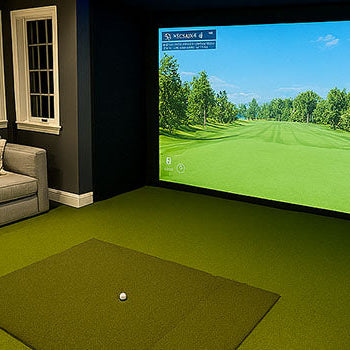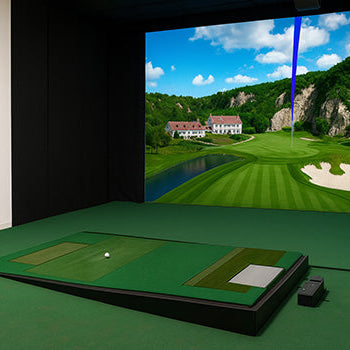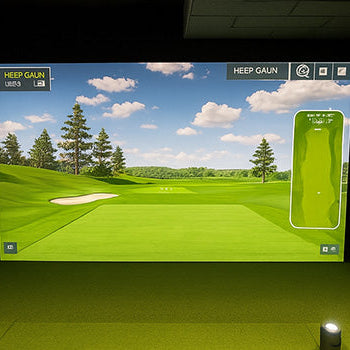Dreaming of tee time without rain delays or lost balls in the rough? Indoor Golf Simulator businesses are teeing up across the UK, and yes, they can be seriously profitable. With golfers craving year-round play and high-tech setups drawing in crowds, this isn’t just a hobby. It’s a business opportunity.
Short answer? Yes, golf simulator businesses can make money. Big money, when done right. Stick around to see how the numbers stack up, what it costs to get started, and what separates the top earners from the rest.

The Revenue Streams: How Simulator Businesses Make Money
Indoor golf isn't just about practicing your swing anymore. It's a full-on experience, like a driving range, sports bar, and training centre rolled into one. That means multiple ways to cash in.
Bay Rentals: The Primary Source of Income
Let’s start with the bread and butter: hourly bay rentals. Players pay around £25–£40 an hour during peak times, and slightly less in quieter slots. Even a small site with two or three bays can pull in solid income with decent foot traffic.
If you hit a 50% average occupancy rate (which many do), you’re already covering your core costs and turning a profit. Bay hire brings in the bulk of your revenue, and it’s steady, predictable income.
Food and Beverage Sales: The Biggest Profit Multiplier
Here's where things get really tasty, literally. Adding drinks and snacks boosts customer spend without increasing simulator use. Think craft beers, stone-baked pizzas, and barista coffee.
A couple of guys book a bay for two hours, add a few drinks, maybe some wings, and suddenly their £30 session becomes a £70 night out. Profit margins on food and drink? Often well over 65%.
Coaching and Lessons with Golf Professionals
Many venues bring in local pros to run lessons, either on a revenue split or rental basis. You give them space; they bring their students, and elevate your brand.
Some even go hybrid: coaching during the day, league play at night. A busy coach doing 20+ lessons a week at £50 each can generate thousands monthly, with minimal cost to you.
Leagues, Tournaments, and Corporate Events
Leagues aren’t just fun, they’re retention gold. Weekly leaderboards, prizes, and team banter keep players coming back.
Corporate nights are another cash cow. A single 40-person event at £45 per head? That’s £1,800 in one evening, often midweek when you'd otherwise be quiet.
Club Fitting and Retail Sales
Partnering with major golf brands allows you to offer fittings, sell gear, and even provide custom clubs. Many golfers want to buy from someone they trust, especially after testing it on-site.
A single driver sale can net you more than an hour of bay time, and loyal customers will keep coming back for balls, gloves, and accessories.

The Major Costs: Understanding Your Initial and Ongoing Expenses
Before you start counting your profits, let’s talk investment. If you're wondering how much does it cost to start a golf simulator business, here’s the breakdown.
Initial Investment: Simulators, Screens, Projectors, and PCs
This is the heart of your operation. A full simulator setup (hardware, tracking, software, and visuals) can cost anywhere from £20,000 to £75,000 per bay.
Want top-tier tech like TrackMan or Full Swing? You’ll be closer to that upper range. Cheaper systems exist, but tech quality directly affects customer experience, and repeat business.
The Lease: Renting a Suitable Commercial Space
Location matters. You’ll need 4–5 metres of width and at least 3 metres ceiling height per bay, plus space for seating, lounge, or bar areas.
Urban locations with foot traffic may run £1,500–£6,000 a month, but visibility and access can be worth every penny. A back-street warehouse might be cheaper, but will people find it?
Fit-Out Costs: Construction, Interior Design, and Furnishings
Think beyond tech. Customers expect comfy seating, good lighting, and clean, stylish interiors. Soundproofing, wall finishes, custom flooring, it all adds up.
Realistically, you're looking at £30,000–£100,000 in fit-out costs, especially if you're adding a bar, retail display, or lounge area.
Ongoing Overheads: Staff, Utilities, Software Subscriptions, and Marketing
The monthly bills won’t be tiny. Expect:
-
Staff wages at £10–£15/hour
-
Utilities (especially electricity + climate control): £500–£900/month
-
Software licences: £250–£400 per bay per year
-
Marketing spend: 5–10% of monthly revenue to stay visible online and offline
Smart budgeting keeps the lights on and your booking calendar full.
Building a Financial Forecast: A Sample Profit and Loss
Numbers don’t lie, and planning ahead helps you sleep at night. Let’s map out how the business actually performs once it’s rolling.
Estimating Your Occupancy Rates
This is your golden metric. Let’s say:
That gives you roughly a 48% average overall. It’s a cautious but realistic target—plenty of venues do more.
Setting Your Pricing Strategy
Don’t just copy the competition, know your market.
Smart pricing smooths out cash flow and maximises off-peak use.
Calculating Your Break-Even Point
With two bays, you’re looking at a break-even point around 38% occupancy if you’re charging standard rates.
Cross that threshold, and profits start to snowball, especially with F&B and events. Many owners hit six figures in year two once they dial in their strategy.
Key Factors for a Profitable Golf Simulator Business
Success isn’t just about having shiny tech, it’s about the whole package. These are the levers that move the needle.
Location: Footfall, Visibility, and Demographics
Busy high streets, retail parks, or near gyms and sports centres all work. Bonus points if there’s parking and you’re visible from the road.
You want passing trade and easy access, not a maze behind a warehouse.
The Customer Experience: Quality of Tech and Atmosphere
You’re not just selling simulator time, you’re selling a night out. Comfy seating, great lighting, chilled music, good coffee, it all adds up.
When people leave saying, “That was fun. Let’s do it again,” you’ve nailed it.
Effective Marketing and Community Building
Socials are your best friend. Behind-the-scenes videos, customer highlights, trick shot clips, this stuff gets shared. Add local golf clubs, society tie-ins, and pro nights for deeper engagement.
People don’t just want to play, they want to belong.
Diversified Revenue Streams Beyond Just Bay Hire
If you’re only relying on bay rentals, you’re leaving money on the table. Add food, merch, coaching, tournaments, and retail, and suddenly one guest becomes five revenue opportunities.
More offerings = more reasons to come back.

The Verdict: A Potentially Lucrative Business with the Right Model
So, are golf simulators a good business in the UK? If you blend the right tech, a great vibe, solid pricing, and community-driven marketing? yes, 100%.
Golfers want to play all year. You give them the space, the tools, and the experience, and they’ll keep coming back.
With smart planning and a love for the game, an indoor golf simulator business isn’t just viable. It’s a hole-in-one.








